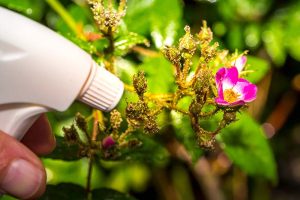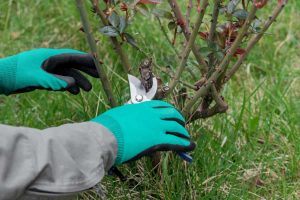An iconic symbol of love and beauty, the rose graces gardens and landscapes with its vibrant colors and pleasant fragrance. But like any other plant, roses are susceptible to diseases and pests that stunt their growth and overall health. In this comprehensive guide, we examine common diseases and pests that affect roses and provide effective strategies for their prevention and management.
Common Rose Pests
- Aphids: These small, soft-bodied insects feed on rose sap, which causes the leaves to curl and turn yellow. Regularly check roses for aphids and control their numbers with natural predators such as ladybugs or by spraying them lightly with soapy water.
- Thrips: Thrips are slender insects that feed on rose petals, which gives them their silvery appearance. Introduce predatory mites to the garden or use neem oil to effectively control thrips.
- Japanese beetles: These iridescent pests devour rose petals, resulting in a shriveled appearance. Pick them by hand or use pheromone traps to control their numbers.
Common Diseases of Roses
- Black spot: Black spot is a fungal disease that causes dark spots on fringed-edged leaves, leading to leaf drop. Plant roses in a well-ventilated area, cut off infected leaves and use fungicides as a preventative measure.
- Powdery Mildew: This disease produces a white powdery substance on the leaves that inhibits photosynthesis. Watering at the base of plants, providing adequate spacing, and using fungicide sprays can help prevent powdery mildew.
- Rust: Rust appears as orange or rust-colored spots on the undersides of leaves, causing leaves to drop prematurely. Remove infected leaves, provide good air circulation and use a fungicide to control rust.
Prevention and management
- Cultivation Practices: The basis of rose pest management is to keep plants healthy. Make sure the roses are properly spaced, provide full sun, basic water, and prune regularly to encourage air circulation.
- Natural Predators: Control pest populations biologically by introducing beneficial insects such as ladybugs, lacewings and predatory mites into your garden.
- Disease-resistant varieties: Choose rose varieties that are resistant to common diseases to reduce the risk of infection.
- Regular Inspections: Inspect roses regularly for signs of disease and pests. Early detection can lead to rapid intervention.
- Organic Solutions: Treat minor pest and disease problems with organic remedies such as neem oil, garlic spray or baking soda solution.
Trim and Hygiene
Regular pruning is essential to keep your rose bushes healthy and vibrant. Pruning helps remove dead or diseased wood, improves air circulation and encourages new growth. When pruning, make a clean cut above the leaf buds, taking care to leave the center of the shrub open to light and air.
In addition, practicing good hygiene in a rose garden can go a long way in preventing the spread of disease. Remove and dispose of any fallen leaves, petals, or debris, as they may harbor pests and pathogens. Cleaning pruning tools with a solution of bleach and water between prunings also helps prevent the spread of disease from one plant to another.
Integrated Pest Management (IPM)
Integrated pest management is a holistic approach to pest control that combines strategies to minimize environmental impact while effectively controlling the problem. IPM involves regularly checking your garden for problems, using a combination of cultural, biological and chemical control methods, and tailoring your methods to the specific needs of your roses.
By implementing IPM, you can create a sustainable and balanced environment that encourages natural enemies, reduces reliance on chemical treatments and promotes the long-term health of your roses.
Online Resources and Community Support
The Internet is an invaluable resource for rose enthusiasts who want to learn more about pest control. There are many rose-specific gardening forums, websites and social media groups where you can seek advice, share experiences and gain insights from fellow gardeners. These platforms can provide practical tips, troubleshooting advice, and recommendations for effective treatments.
Conclusion
Roses hold a special place in the world of gardening, captivating our senses with their beauty and fragrance. To keep your rose garden an oasis of flowers, it’s critical to be aware of common pests and diseases and take proactive steps to prevent and control them. By embracing good cultural practices, natural solutions, and staying connected to the gardening community, you can practice nurturing a garden that is not only pleasing to the eye, but also a healthy and harmonious ecosystem.
Frequently Asked Questions
1. What are the most common pests that affect roses?
Common pests that affect roses include aphids, thrips, Japanese beetles and spider mites. These pests feed on rose sap and leaves and can damage plants.
2. How do I prevent aphids from infesting my rose garden?
To prevent aphids, encourage natural predators such as ladybugs and lacewings. You can also spray a mixture of soap and water on the leaves, which will help prevent aphids from settling.
3. What is a black spot and how to deal with it?
Black spot is a fungal disease that causes dark, fringed-edged spots on rose petals. To control black spot, plant roses in a well-ventilated area, prune infected leaves and apply fungicides as needed.
4. Can I use biological solutions to treat rose diseases?
Yes, organic solutions such as neem oil, garlic spray, and baking soda solution can be effective in treating little rose diseases. They offer an environmentally friendly alternative to chemical treatments.
5. How do I implement Integrated Pest Management (IPM) in a rose garden?
Integrated pest management involves regular monitoring of your garden using a combination of cultural, biological and chemical control methods. By using IPM you can maintain a healthy rose garden while minimizing your impact on the environment.



